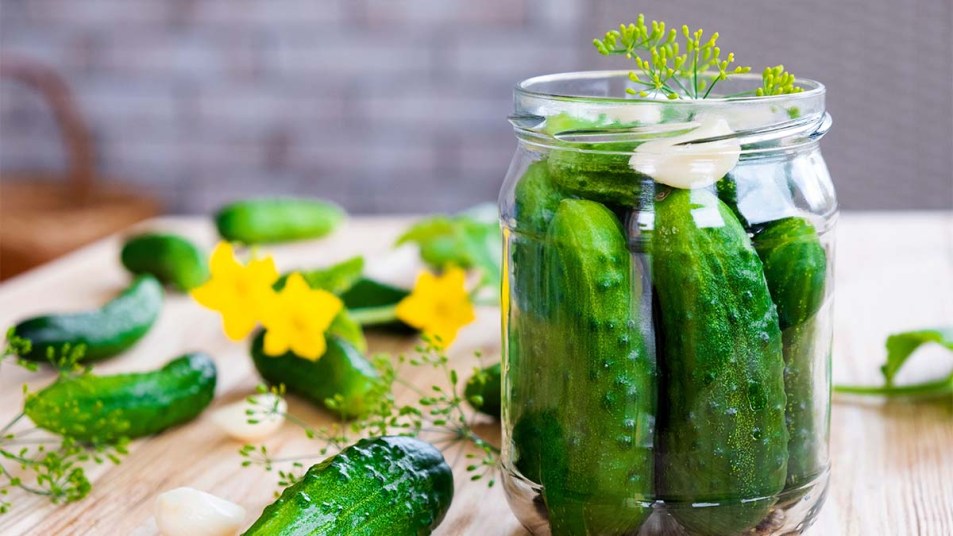How To Preserve Fruits and Veggies Through Fall and Beyond (and Your Summer Harvest Longer)
Plus, you'll be able to spend less at the grocery store.

The leftover fruits and vegetables from your summer garden don’t have to go to waste. In fact, it’s easy to turn them into pickles, jam, or a freezer-friendly veggie mix that’ll keep for months. Knowing how to preserve produce is also a money-saver. “While your freshly-grown produce may not last long, there are easy ways to preserve your fruits and veggies so that you can still enjoy them and cut a few items off your grocery list,” Rebecca Sears, Chief Gardening Guru for Ferry-Morse, tells Woman’s World. Here’s how to keep fruits and veggies fresh, preserved, and edible through fall and beyond.
Safety Tips To Keep In Mind Before Preserving Food
Canning is a dangerous task if you’re not careful. The CDC warns that foodborne botulism (an illness) happens after consuming foods contained with botulinum toxin. Homemade foods that have been incorrectly canned, preserved, or fermented are common sources of this illness; symptoms of foodborne botulism include stomach pain, nausea, and diarrhea. To prevent this, many canning recipes call for sterilizing the jars and lids in boiling water, which helps prevent contaminants from spoiling the food inside.
The National Center for Home Food Preservation (NCHFP) outlines various sterilization guidelines. “All jams, jellies, and pickled products processed less than 10 minutes should be filled into sterile empty jars… Empty jars used for vegetables, meats, and fruits to be processed in a pressure canner need not be pre-sterilized. It is also unnecessary to pre-sterilize jars for fruits, tomatoes, and pickled or fermented foods that will be processed 10 minutes or longer in a boiling-water canner,” the NCHFP notes. For additional safety tips, take a look at the USDA’s complete guide on home canning.
Make your own pickles.
Pickling works to preserve a variety of meats and vegetables including carrots, beats, and cucumbers. According to the chefs at Food Network, there are two main types of pickling:
- Quick pickling involves pouring a hot vinegar brine over vegetables and then letting them cool. Once cooled, they’re ready to enjoy and will last up to two weeks in the fridge.
- Slow pickling consists of filling sterilized jars with produce (sometimes with vinegar added) then submerging them in a heated saltwater brine. After canning, the jars are stored in a cool, dark place. As the pickles sit and rest, good bacteria grows within the jar and fermentation happens. Fully fermented pickles can last four to six months when refrigerated.
Dill is a classic herb to use when pickling, but other spices such as chili flakes and fennel seeds are tasty additions too. Need a couple of recipes to get your pickling journey started? Try this quick pickling recipe for refrigerator dill pickles or the NCHFP’s method for making a fermented version.
Turn fruit into jam.
Fruit is a gem in your home garden and should be treated as such — so why not turn it into a sweet homemade jam that rivals the store-bought kind. Making jam typically involves cooking fruit with sugar or pectin until it reaches 220 degrees Fahrenheit before canning. This temperature ensures that the jam sets into a thick, spreadable mixture as it cools. Unlike jelly, jam contains pieces of the fruit’s fiber and seeds — giving the spread a chunky texture. “For those days when you’re craving something sweet, strawberries can be turned into homemade jam that’ll last up to two years when unopened and stored in a cold, dry place — great for spreading on toast or serving on a charcuterie board,” Sears says. Fruits like grapes, apricots, and plums are also worthy candidates for jam-making.
Freeze fresh vegetables.
Keep green beans, corn, and broccoli fresher longer by blanching the vegetables in boiling water before freezing them. Blanching stops the action of enzymes in veggies, which may otherwise lead to discoloration and loss of flavor. After blanching, drain the veggies so they’re completely dry and divide them into plastic bags. The University of Mississippi Extension notes that veggies can last anywhere from eight to 12 months in the freezer; check out the university’s guide on how to freeze vegetables for a full list of freezer-friendly veggies and blanching times. Also, watch the video below for step-by-step instructions.
These food preservation methods all require planning and organizing your fridge or freezer. But savoring your warm weather harvest during the chilly months — while also saving money — will make the effort worthwhile.












